Summary Overview
Dry Peas Market Overview
The global dry peas market is experiencing consistent growth, driven by increasing demand across industries such as food and beverages, animal feed, and agriculture. This market encompasses various types of dry peas, including whole peas, split peas, and pea flour. Our report provides a detailed analysis of procurement trends, emphasizing cost optimization strategies and the adoption of digital tools to enhance procurement and supply chain processes.
Key future challenges in procurement include managing fluctuating crop yields, addressing supply chain stability, and meeting growing demands for sustainable agricultural practices. Digital procurement tools and strategic sourcing are essential for optimizing the dry peas supply chain and ensuring long-term competitiveness. As global demand continues to rise, companies are leveraging market intelligence to enhance operational efficiency and mitigate risks.
The dry peas market is expected to maintain steady growth through 2032, with key highlights including:
-
Market Size: The global dry peas market is projected to reach USD 8.25 billion by 2032, growing at a CAGR of approximately 3.24% from 2024 to 2032.
Growth Rate: 3.24%
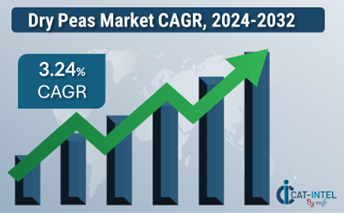
-
Sector Contributions: Growth in the market is driven by: -
Food and Beverage Demand: Increased use of dry peas in plant-based protein products, soups, and snacks. -
Animal Feed Industry: Rising adoption of dry peas as a cost-effective and nutritious ingredient in livestock feed. -
Technological Transformation: Advancements in agricultural practices, such as precision farming and genetically improved pea varieties, are enhancing yields and reducing costs. -
Innovations: Innovative processing techniques like fractionation and extrusion are creating high-value products such as pea protein isolate and starch. -
Investment Initiatives: Companies are investing in advanced storage and logistics infrastructure to preserve the quality of dry peas and reduce wastage. -
Regional Insights: Asia Pacific and North America remain significant contributors due to robust agricultural infrastructure and growing consumer awareness of plant-based diets.
Key Trends and Sustainability Outlook:
-
Digital Integration: Automation in farming operations and supply chain management is improving efficiency and reducing errors. -
Advanced Techniques: Adoption of eco-friendly farming methods, including no-till practices and sustainable irrigation. -
Focus on Sustainability: Emphasis on reducing environmental impact through sustainable farming and processing practices. -
Customization Trends: Rising demand for customized dry pea derivatives for specific applications such as gluten-free products. -
Data-Driven Farming: Utilizing analytics to optimize yields, manage resources efficiently, and ensure consistent quality standards.
Growth Drivers:
-
Rising Plant-Based Diets: Increasing consumer preference for plant-based proteins and natural food ingredients. -
Animal Feed Demand: High nutritional value of dry peas driving their use in livestock feed formulations. -
Sustainability Goals: Growing interest in dry peas as a sustainable alternative to traditional protein sources. -
Regulatory Compliance: Adherence to stringent food safety and quality standards in agriculture and food production. -
Customization: Increasing need for tailored pea derivatives in specialized food and beverage applications.
Overview of Market Intelligence Services for the Dry Peas Market:
Recent analyses have highlighted key challenges such as fluctuating crop yields, climate-related risks, and the need for diversified supply chains. Market intelligence reports offer actionable insights into procurement opportunities, helping companies identify cost-saving measures, optimize supplier management, and enhance supply chain resilience. These insights also support compliance with industry regulations and uphold high standards of quality while effectively managing costs.
Procurement Intelligence for Dry Peas: Category Management and Strategic Sourcing:
To stay competitive in the dry peas market, companies are streamlining procurement processes through spend analysis and supplier performance tracking. Effective category management and strategic sourcing are critical to reducing procurement costs and ensuring a consistent supply of high-quality dry peas. By leveraging actionable market intelligence, businesses can refine their procurement strategies and negotiate favourable terms for their dry pea requirements. 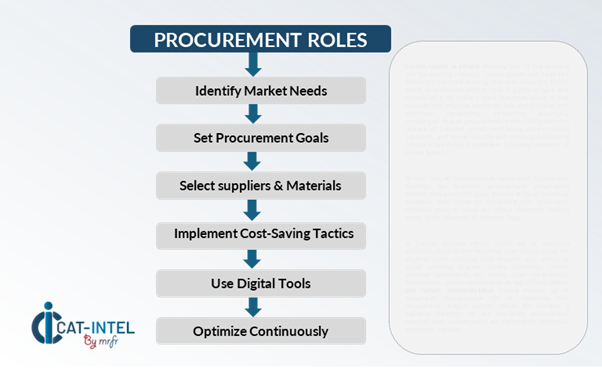
Pricing Outlook for Dry Peas: Spend Analysis
The pricing outlook for dry peas is expected to remain moderately stable, with potential fluctuations influenced by several key factors. Changes in global crop yields, fluctuations in transportation costs, and evolving regulatory standards for agricultural practices are significant drivers of dry pea price trends. Additionally, the rising demand for plant-based protein products and sustainable farming practices is contributing to upward price pressures.
Graph shows general upward trend pricing for dry peas and growing demand. However, there may be fluctuations influenced by economic conditions, technological advancements, and competitive dynamic.
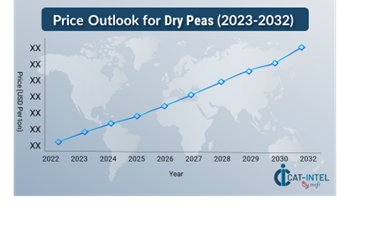
Efforts to streamline procurement processes, enhance supplier relationships, and adopt sustainable agricultural innovations are essential for controlling costs. Leveraging digital tools for market monitoring, price forecasting through analytics, and efficient inventory planning can further enhance cost management.
Partnering with reliable suppliers, negotiating long-term contracts, and optimizing farming workflows are key strategies to effectively manage dry pea pricing. Despite these challenges, maintaining crop quality, aligning with sustainability goals, and adopting advanced agricultural techniques will be critical to sustaining cost efficiency.
Cost Breakdown for Dry Peas: Total Cost of Ownership (TCO) and Cost-Saving Opportunities
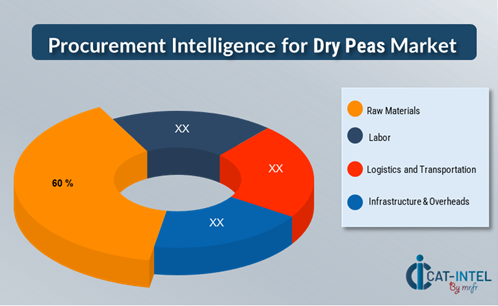
-
Raw Materials (60%)-
Description: The primary costs in dry pea procurement include the cultivation of high-quality seeds, fertilizers, and other agricultural inputs. These costs are significantly influenced by climate conditions, global demand, and regional agricultural policies. -
Trends: Companies are adopting strategies such as sourcing high-yield seed varieties, implementing precision farming, and collaborating with local farmers to mitigate price volatility. The increased use of organic and sustainably farmed dry peas is also shaping price trends, often resulting in higher premiums for eco-friendly practices.
-
- Labor (XX%)
- Logistics and Transportation (XX%)
- Infrastructure & Overheads (XX%)
Cost-Saving Opportunities: Negotiation Levers and Purchasing Negotiation Strategies
In the dry peas industry, optimizing procurement processes and employing strategic negotiation tactics can lead to significant cost savings and improved operational efficiency. Establishing long-term agreements with pea suppliers, particularly in key growing regions, can result in better pricing and favourable terms such as volume discounts and reduced shipping costs. Bulk purchasing and forward contracts also provide opportunities to secure lower rates and mitigate price volatility.
Collaborating with suppliers that prioritize sustainability and innovative farming techniques can offer additional advantages, including access to high-yield, eco-friendly dry peas and cost reductions through efficient cultivation and processing methods. Implementing digital tools for supply chain management, such as real-time inventory tracking and demand forecasting systems, enhances operational efficiency, minimizes stockouts, and reduces overall procurement costs. Diversifying supplier networks and adopting multi-supplier strategies can mitigate risks such as crop failures or logistical disruptions and provide greater leverage during negotiations.
Supply and Demand Overview for Dry Peas: Demand-Supply Dynamics and Buyer Intelligence for Effective Supplier Relationship Management (SRM)
The dry peas market is experiencing steady growth, driven by rising demand across industries such as agriculture, food production, and plant-based protein sectors. The balance between supply and demand is influenced by factors like weather conditions, crop yields, production costs, and trade policies.
Demand Factors:
-
Plant-Based Protein Growth: The increasing demand for plant-based protein in food and beverages is driving the need for dry peas as an affordable and sustainable protein source. -
Sustainability Goals: The growing emphasis on sustainable agriculture and eco-friendly food production has increased demand for dry peas, particularly those sourced through organic and environmentally responsible farming methods. -
Industry-Specific Needs: The food processing industry requires dry peas for a variety of products such as snacks, soups, and protein-rich meals. Additionally, animal feed and agricultural applications contribute to demand. -
Health and Nutrition Trends: Rising consumer awareness of plant-based diets and health benefits is fuelling demand for dry peas in diverse food applications.
Supply Factors:
-
Climate Conditions and Crop Yields: Weather patterns significantly impact the availability and price of dry peas, as crops are sensitive to climate variations. -
Farmers' Production Practices: Innovations in farming techniques, such as precision agriculture and improved irrigation methods, are increasing yields and enhancing supply efficiency. -
Global Trade and Regulations: Trade policies, tariffs, and regulations governing the agricultural industry influence the availability and pricing of dry peas in different markets. -
Operational Efficiency: Advances in logistics and supply chain optimization are improving distribution capabilities, ensuring a steady supply of dry peas to meet rising demand.
Regional Demand-Supply Outlook: Dry Peas
The Image shows growing demand for dry peas in both Asia Pacific and North America, with potential price increases and increased Competition.
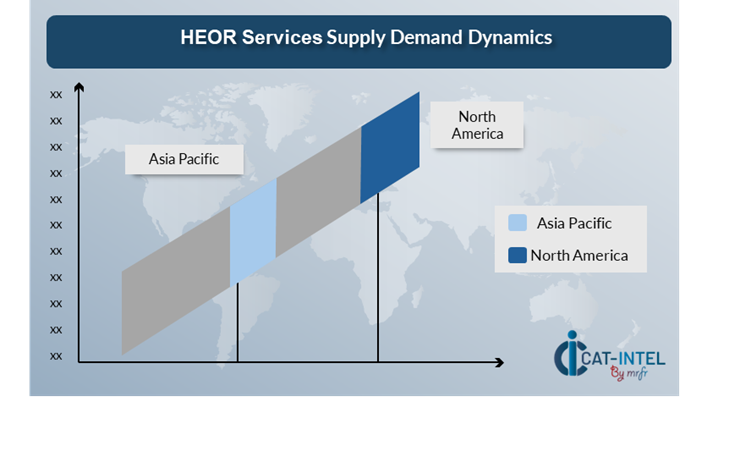
Asia Pacific: Dominance in Dry Peas MarketAsia Pacific, particularly countries like India, China, and Australia, is emerging as a significant player in the global dry peas market due to several key factors:
-
High Production Capacity: India is one of the largest producers and consumers of dry peas in the region, supported by its vast agricultural land and favourable climatic conditions. China and Australia are also increasing production to meet the rising demand for pulses. -
Technological Integration: The region is rapidly adopting new farming technologies, such as improved irrigation techniques, genetically enhanced seed varieties, and precision farming, resulting in better yields and more efficient cultivation processes. -
Growing Plant-Based Protein Demand: Asia Pacific is experiencing a growing shift toward plant-based diets, particularly in urban centres. Dry peas, with their high protein content, are gaining popularity as a sustainable and affordable protein source for both food and animal feed. -
Focus on Sustainability: There is an increasing focus on sustainable agriculture practices, with many farmers adopting crop rotation, minimal pesticide usage, and organic farming techniques.
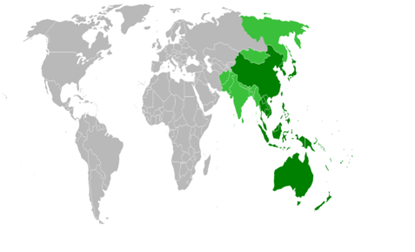
Asia Pacific Remains a key hub dry peas price drivers Innovation and Growth.
Supplier Landscape: Supplier Negotiations and Strategies
The supplier landscape in the dry peas market is diverse, with both global and regional suppliers playing critical roles in driving industry trends. Suppliers impact key factors such as pricing, quality, and supply chain efficiency. While major suppliers dominate the market, smaller, specialized suppliers cater to niche demands, such as organic dry peas or region-specific varieties.
The dry peas supplier ecosystem spans across different regions, with major producers in North America, Asia Pacific, and Europe meeting the growing demand for dry peas in both domestic and international markets. As the demand for dry peas increases, suppliers are focusing on enhancing production capabilities, improving quality control measures, and expanding their market reach to offer competitive pricing and supply stability. Sustainability practices, such as the use of organic farming methods and improved crop rotation, are becoming more prevalent to meet the growing demand for environmentally friendly products.
Key Suppliers in the Dry Peas Market Include:
- China National Chemical Corporation (ChemChina)
- Pulse Growers Association
- Australia’s Pulse Australia
- India Pulses and Grains Association
- Agro Products & Agencies Pvt. Ltd.
- Wittenberg Seed Company
- Lentil and Pulse Growers of Saskatchewan
- Olam Group
- Global Pulses Inc.
- Pulse Processing Plant

Key Developments Procurement Category Significant Development:
Significant Development |
Description |
Market Growth |
The dry peas market is witnessing steady growth, driven by increased demand for plant-based proteins, especially in the food and feed sectors, and the growing focus on sustainability in agriculture. |
Sustainability Focus |
There is a rising emphasis on sustainable farming practices, including crop rotation and minimal pesticide use, to meet environmental standards and support long-term agricultural health. |
Product Innovation |
Advances in breeding techniques and seed development are improving yield, disease resistance, and quality, leading to a more reliable and higher-quality dry pea supply. |
Technological Advancements |
Innovations such as precision farming, automated planting and harvesting technologies, and better crop management systems are boosting productivity and reducing costs. |
Global Trade Dynamics |
Changes in international trade policies, tariffs, and regional agreements, particularly in Asia Pacific, North America and Europe, are influencing the flow of dry peas, affecting global supply and pricing. |
Customization Trends |
The demand for specialized dry peas for different applications, such as higher protein content for plant-based food products and specific varieties for animal feed, is increasing. |
|
Dry Peas Attribute/Metric |
Details |
Market Sizing |
The global dry peas market is projected to reach USD 8.25 billion by 2032, growing at a CAGR of approximately 3.24% from 2024 to 2032. |
Dry Peas Technology Adoption Rate |
Around 40% of dry pea farmers are adopting advanced agricultural technologies, such as precision farming and seed development, to enhance yield and sustainability. |
Top Dry Peas Industry Strategies for 2024 |
Key strategies include improving crop management, adopting sustainable farming practices, enhancing seed quality, and increasing market reach for plant-based products. |
Dry Peas Process Automation |
Approximately 30% of dry pea producers have implemented automation in planting, harvesting, and processing to improve productivity and reduce operational costs. |
Dry Peas Process Challenges |
Major challenges include managing crop diseases, fluctuating market prices, adapting to climate change, and ensuring sustainability in farming practices. |
Key Suppliers |
Leading suppliers in the dry peas market include AGT Foods & Ingredients (Canada), Trident Ag (USA), and Cargill (USA), offering diverse dry pea solutions. |
Key Regions Covered |
Prominent dry pea production regions include China Asia Pacific North America (Canada, USA), Europe (Russia, France) with significant demand in food, feed, and plant-based product industries. |
Market Drivers and Trends |
Growth is driven by increasing demand for plant-based proteins, advancements in agricultural technology, the need for sustainable farming practices, and rising consumption in the food and animal feed industries. |

